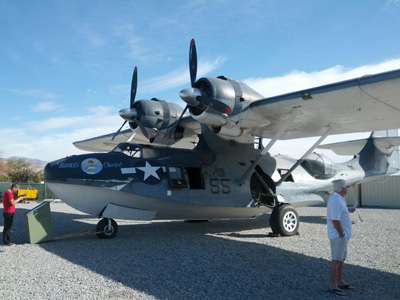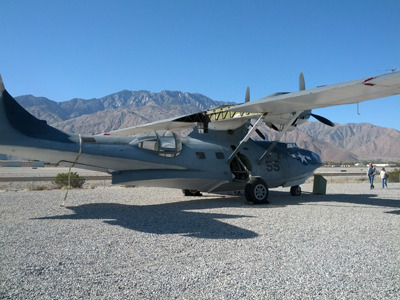A Rendezvous With History
There’s a commonly-accepted saying in antisubmarine warfare… The best way to hunt a submarine is with another submarine.
Having spent the better part of two and a half decades chasing subs, training to chase subs, and thinking about how to chase subs, I’ve come to believe in the accuracy of that particular adage. As a career tin can sailor, I’d love to be able to say that the ultimate ASW platform is a U.S. Navy destroyer. That may have actually been true at certain points on the timeline of struggle between surface and subsurface warships, but for at least the last few decades, the balance in cross-boundary warfare has been tilted heavily in favor of submarines.
This (of course) raises an obvious question… What’s the second best way to hunt a submarine? Recently, I had a chance to lay hands on a piece of hardware that perfectly embodies the answer.
My wife and I were in Palm Springs a few weeks ago, and after driving past it several times, we decided to make a stop at the famous Palm Springs Air Museum. If you’re ever in the area, it’s a must-see. They have one of the largest collections of flyable World War II aircraft in the world, and you’re allowed to touch and examine most of the exhibits. For me, the biggest attraction was the PBY Catalina. It caught my attention from the street, and my eye was drawn back to it every time we passed within line-of-sight.
 For those who aren’t familiar with this beautifully-ugly seaplane, it’s an enormous twin-engine flying boat, built by Consolidated Aircraft in the 1930s and 1940s. With a buoyant fuselage, hydro-dynamically sculpted for landing and taking off directly from the ocean, the Catalina served with every branch of the U.S. military throughout World War II. These planes saw countless tours of combat duty as patrol bombers, convoy escorts, search and rescue platforms, cargo carriers, and (need I say it?) sub hunters.
For those who aren’t familiar with this beautifully-ugly seaplane, it’s an enormous twin-engine flying boat, built by Consolidated Aircraft in the 1930s and 1940s. With a buoyant fuselage, hydro-dynamically sculpted for landing and taking off directly from the ocean, the Catalina served with every branch of the U.S. military throughout World War II. These planes saw countless tours of combat duty as patrol bombers, convoy escorts, search and rescue platforms, cargo carriers, and (need I say it?) sub hunters.
At their top-rated speed of about 196 miles per hour, the Catalinas were considered slow even at the outset of the war. And their sluggish performance rapidly lagged farther behind the power curve as innovations in aviation technology continued to accelerate.
Despite their lackluster flight characteristics, they remained in continual military service for more than fifty years. There were a handful of Catalinas in use by foreign militaries as recently as the late 1980s, and even now—eight decades after its initial test flights—the aircraft is still in use in aerial firefighting operations all over the world.
 My own introduction to the Catalina occurred when I was about six years old. I was watching the Rodgers and Hammerstein musical South Pacific on television with my dad—generally ignoring the show tunes and story line while soaking up the 20th Century Fox Technicolor interpretation of the south seas islands—when the comically-cumbersome shape of a seaplane appeared on the screen. I was instantly fascinated by this odd-looking machine. Maybe it was because the Catalina bore so little resemblance to other planes that I was familiar with. Or maybe I was enthralled by the idea that such an unlikely contraption could skim along the surface of the waves and then jump into the sky and fly away. I don’t know what it was that captured my imagination, but I do know that my crayon drawings of aerial combat suddenly took on a new and unlikely star. In my Crayola depictions of battle, the lumbering bulk of the Catalina displaced the shark-like forms of my previous two favorites: the P-40 Warhawk and the P-51 Mustang.
My own introduction to the Catalina occurred when I was about six years old. I was watching the Rodgers and Hammerstein musical South Pacific on television with my dad—generally ignoring the show tunes and story line while soaking up the 20th Century Fox Technicolor interpretation of the south seas islands—when the comically-cumbersome shape of a seaplane appeared on the screen. I was instantly fascinated by this odd-looking machine. Maybe it was because the Catalina bore so little resemblance to other planes that I was familiar with. Or maybe I was enthralled by the idea that such an unlikely contraption could skim along the surface of the waves and then jump into the sky and fly away. I don’t know what it was that captured my imagination, but I do know that my crayon drawings of aerial combat suddenly took on a new and unlikely star. In my Crayola depictions of battle, the lumbering bulk of the Catalina displaced the shark-like forms of my previous two favorites: the P-40 Warhawk and the P-51 Mustang.
In later years, when I began to study the history of ASW, I was surprised to learn that my old friend the PBY Catalina was one of the earliest and most effective sub hunters ever built. Although historical accounts vary slightly on the exact numbers, Catalinas are known to have sunk at least 19 Japanese submarines in the Pacific theater, and somewhere between 35 and 50 German U-boats in the Atlantic. In all the decades before or since, the Catalina’s record has never been equaled (or even seriously approached) by any other antisubmarine aircraft. This is especially impressive when you know that German U-boats were well-armed with anti-aircraft guns by 1943, and that many of the Catalina’s kills were the result of brutal shootouts with the submarines they were hunting.
All of these facts and childhood memories were swirling around in my head as we bought our tickets to the Palm Springs Air Museum, and made our way through the display hangars to the outdoor runway exhibits. We strolled past an F8F Bearcat, an F4U Corsair, a B25 bomber, an ex-Soviet MiG-21, and so many amazing warplanes that I literally lost count. We eventually went back and looked at the other planes, but I had really come to see the Catalina.
There she was, sitting on the concrete under the bright California sun. A great whale of a seaplane: dented, oil-stained, and showing every minute of her seventy-plus years. She was every bit as ungainly as I’d imagined, and she was utterly beautiful.
I laid my palm on the battered sheeting of her curved fuselage and felt the history of this magnificent old war bird seep through the sun-warmed metal into my fingers. I wished she could tell me about the things she had seen; the eight-man crews who had flown her into action; the countless thousands of miles that had scrolled beneath her salt-flecked wings. Unfortunately, the old girl’s powers of speech were limited to the words printed on the museum placard, and the aura of bygone adventure that I soaked up while standing in her presence.
I can’t say that I came away from the encounter with more wisdom or knowledge than I walked in with. Nor can I claim to have been fundamentally altered by a few minutes of quiet communion with an aging aircraft. But I have changed my mind about one small point. I no longer buy into the idea that the best way to hunt a submarine is with another submarine. As far as I’m concerned the best way to hunt a submarine is with a preposterous old seaplane, covered in oil-stains, and reeking of unspoken history.
This is a flat contradiction of accepted tactical wisdom, but I know that I’m right. Just give me a blank sheet of paper and a box of Crayolas. I can prove every word.



